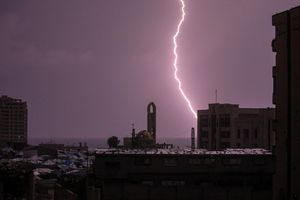Alarming Civilian Casualty Statistics in the Gaza Strip
Analysts have reported that the number of women and children killed in the Gaza Strip due to Israeli airstrikes has exceeded 10,000. Even by conservative estimates, the number of women (over 4,000) and children (6,150) killed surpasses the number of women and children who died in the Ukraine war over the past year and nine months by more than double.
On the 25th (local time), The New York Times (NYT) analyzed that the rate of increase in civilian deaths in the Gaza Strip during the Israeli military’s bombing campaign is exceptionally high, unprecedented in the 21st century. Neta Crawford, a modern warfare expert and professor at Brown University in the U.S., pointed out that the scale of deaths from Israeli airstrikes is approaching the 12,400 deaths caused by U.S. forces in the nearly 20-year-long Afghan war, stating, “More have died in a much shorter period than in other wars.”
Increase in Women and Children Among Gaza’s Casualties
According to the United Nations and others, the proportion of women and children among the total casualties in the Gaza Strip in this war, with the majority of Hamas militants being male, is 69%. Considering that this ratio was 41% during the 2021 armed conflict, 38% during the 2014 war, and 39% during the 2008-2009 war, Rick Brennan, the World Health Organization’s (WHO) Regional Emergency Director for the Eastern Mediterranean, described this as an “exceptional statistic” that contradicts the usual trend.

Heavy Bombardment in Densely Populated Gaza
The NYT cited the fact that the Israeli military has conducted a massive number of airstrikes using heavy bombs in the densely populated, narrow Gaza Strip as the reason for the unprecedented scale of casualties. The Israeli military has reported that it has targeted more than 15,000 locations in the Gaza Strip during this war.
According to an anonymous high-ranking U.S. military official, about 90% of the bombs dropped by the Israeli military on the Gaza Strip in the first two weeks after the outbreak of the war were large, satellite-guided bombs weighing between 1,000 and 2,000 pounds (approximately 454 to 907 kilograms).
Indeed, when the Israeli military bombed Jabalia, the largest refugee camp in the Gaza Strip, on May 31, they used at least two 2,000-pound bombs. According to the British conflict monitoring group Airwars, this resulted in at least 126 civilian deaths, more than half of which were children, as confirmed by their own investigation.
Experts have pointed out that it is surprising for the Israeli military to freely use super-sized bombs, which can demolish apartments, in densely populated urban areas.
The U.S. military used the most common 500-pound (approximately 227 kilograms) bombs in the battles of Mosul in Iraq and Raqqa in Syria against the Islamic State (IS), and there was self-assessment that these were excessively large. The size of the Israeli military’s bombs is four times that.

Marc Garlasco, a former senior intelligence analyst at the U.S. Department of Defense, said, “It surpasses anything I’ve seen in my work so far,” and pointed out that one would have to go back to the Vietnam War or World War II to find a similar case where a large number of super-sized bombs were dropped in such a narrow area.
Challenges in a Crowded and Confined Gaza Strip
Brian Castner, a former U.S. Air Force Explosive Ordnance Disposal officer and now a weapons investigator for Amnesty International (AI), also said, “They are using super-sized weapons in areas with extremely high population density,” and evaluated this as “the worst possible combination of factors.”
Unlike the wars in Ukraine, Iraq, and Afghanistan, which have seen nationwide fighting, the very small Gaza Strip, with all its borders closed, offers no safe place for civilians to take refuge. Moreover, although the Israeli military previously announced to civilians in the northern Gaza Strip to evacuate to the south, they continue to carry out airstrikes in the southern Gaza Strip and other areas.
Castner also pointed out that Israel appears to be conducting airstrikes at too fast a pace to reduce civilian casualties. Usually, a process is carried out to determine whether civilians live in a target building before an airstrike is executed. Still, the Israeli military is conducting multiple airstrikes in a short period, making this “impossible,” according to Castner.
By. Cho Yoo Jin










Most Commented